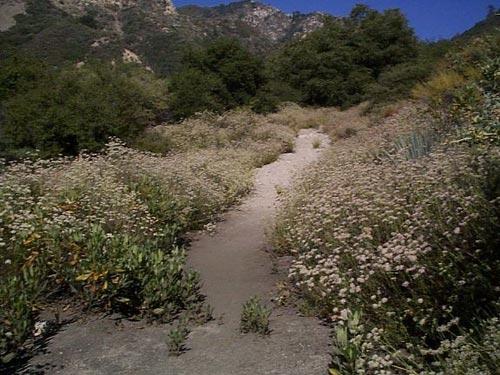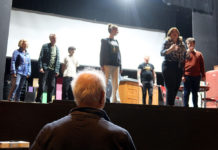Buckwheat…brings to mind a plateful of pancakes! Or a crunchy
buckwheat hulls pillow! The edible buckwheat, Fagopyrum sagittatum,
is in the same family, Polygonaceae, as our wonderful ornamental
buckwheats.
Edible buckwheat is not technically a cereal. It is a
“pseudocereal,” a fruit seed related to rhubard and sorrel. Cereals
are grasses, such as rice, wheat and corn. The buckwheat we eat, in
the form of groats and of course, flour, is also grown for
livestock feed, and for the dark honey that bees produce from its
abundant and very fragrant flowers. Honeybees can make up to 10
pounds of honey a day while foraging on buckwheat. However, it is
not as commonly produced today, as buckwheat is not as popular as
it once was. Buckwheat is grown in moist, cool climates, such as
the northeast and upper Midwest.
Most of the buckwheats we grow in our gardens are in the genus
Eriogonum. There is something about the buckwheats that attract
many people to them. I have several genera in my garden and I love
them all. My hikes in the Sierra, in the Lakes District, the
Rockies and the Texas deserts have all yielded the happy experience
of coming around a bend and discovering a patch of one of the
buckwheats.
They all have a certain look about them that make them easily
(most of the time!) identifiable. Flat, oval leaves, usually in a
whorl of rosettes at the base. The leaves are often heavily felted
which gives them their soft, gray-silver-green look, as if the
moonlight had fallen on them during the night. Rising from the base
or the nodes are slender, sometimes wiry, fuzzy stems, topped with
very distinctive flowers. From a distance, they look like
puffballs, often ivory-to-pale pink and on through the cherriest
(and cheeriest) reds. There are also several beautiful
bright-yellow flowered buckwheats. Eriogonum umbellatum var.
polyanthum is our native.
The flowers, when examined closely, are actually a head of teeny
little flowers, combined together in a flat-topped umbel or in
puffs on a spoke-like circle of stems. They are often so covered
with pollinators that it’s difficult to peer up close at the
individual flowers. It’s not just honeybees drinking up nectar, but
there are tiny little flies and wasps and other little creatures
that will form a cloud around the flowers.
Thus, for their form, which is rather spare and architectural,
their distinctive flowers, their soft fuzzy leaves, and the habitat
value they bring to a garden, no wonder so many of us are
fascinated by the buckwheats. The flowers seem to bloom forever,
and as they go to seed, turn a pretty cinnamon, red-brown color and
can be brought indoors for long-lasting dry flower
arrangements.
To top if off in the desirability department, the seeds are
viable and are loved by birds!
The buckwheats are fairly easy to grow. They love warm, full sun
and are quite drought tolerant. I see the red-flowered buckwheat
(Eriogonum grande var. ‘rubescens’) growing on dry road cuts and
verges, especially at the coast. I saw the same coming down off
Grand Mesa in Colorado this summer, where the soil was very
dry.
I now have four buckwheats around my pond garden. They are best
planted in masses, as the flowers grow tall on stems that tilt and
support each other. Because they can be so wispy, several plants
together make a more colorful statement. I have 5 red buckwheats
and all vary slightly in their color of red. I have Eriogonum
nudum, which is a basal rosette of leaves with a tall stem of
flowers with no leaves at all on the stems (it is “nude”). One of
my favorites is our “plain” old coast variety, Eriogonum
latifolium, with its soft leaves and pale pink poufs of
flowers.
Maybe 5 years ago I put in the Saint Catherine’s Lace buckwheat,
Eriogonum giganteum. It first flowered last spring with two huge
umbels of ivory-colored flowers. This spring there were three. This
buckwheat is really a shrub with gnarly grayish branches. The books
say it could reach 4 to 8 feet tall and 6-10 feet wide. Mine is
maybe 2 feet tall and 2 feet wide. It stands at the top of the berm
right by the waterfall. The birds use it as cover and the
pollinators love it. Its stately form is admired in profile.
Check CalFlora for their inventory of buckwheats. Call them at
528-8813 or your local nursery.
“Natives in the Garden,” a talk by Liz Parsons, THE local native
plant lady, will take place on September 15 at 7:30 pm at the
Luther Burbank Art & Garden Center, on Yulupa Ave. in Santa
Rosa. Don’t miss it, she is so knowledgeable. Call her at 833-2063
for more information.
The native plant sale takes place on October 10 this year at the
Santa Rosa Vets Memorial Bldg. Stay posted for more info.
The very active Windsor Garden Club meets monthly. This new club
is very proactive in the town and has interesting fingers in
several pies! Opportunities abound in their activities. Contact
Thomas Eddy at 529-8819 or: tj****@te***.com
Write me at: jo*******@co*****.net.
48.8
F
Healdsburg
March 17, 2025








